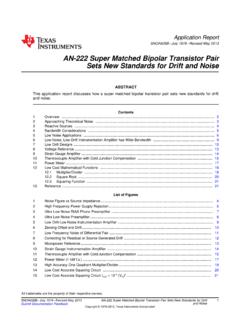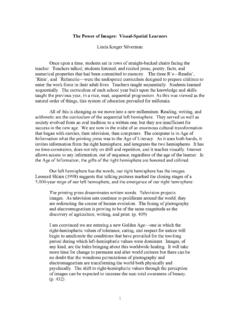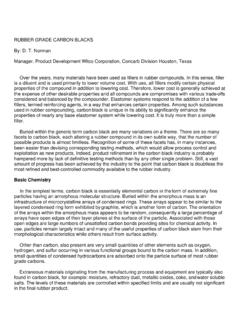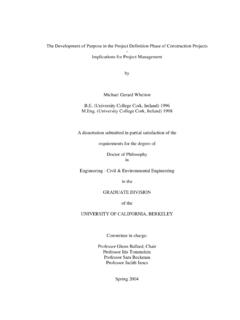Transcription of SELECTION AND SPECIFICATION OF PERMANENT …
1 SELECTION AND SPECIFICATION OF PERMANENT magnet MATERIALS. S. R. Trout Gary D. Wooten Spontaneous Materials Echelon Magnetics, LLC. Abstract: The SELECTION and SPECIFICATION of PERMANENT In a general way, we attempt to outline all the things that a magnets is often done in an incomplete or confusing designer should consider when selecting and specifying a manner, frequently leading to poor product PERMANENT magnet . performance or an unnecessarily expensive design. It is important to conduct a thorough analysis, from the II.
2 SELECTION . earliest stages of the design, by considering all the characteristics and deciding which ones are pertinent. A. Available Choices This paper attempts to introduce a methodology that can be applied to selecting and specifying the best The most popular PERMANENT magnet materials are: ferrite, available grade for any application of a PERMANENT alnico, SmCo and NdFeB. While there are several magnet . processing options, magnets can be divided into fully dense or bonded, leading to isotropic or anisotropic I.
3 INTRODUCTION magnets, and a large number of choices. Selecting the correct PERMANENT magnet for a new design B. Primary Magnetic Properties is a complicated engineering task. There are many factors to consider, some subtle, yet critical to the ultimate Table I shows the basic magnetic properties of the success of the product. With limited training and excess commonly available PERMANENT magnet materials. Figure 1. information available, it is not surprising that engineers is a graphical representation of typical property ranges for often overlook one or more important considerations when two fundamental parameters, Br and Hci.
4 It is essential to selecting a magnet . This can come as a very unpleasant establish the relative importance of each parameter to the surprise, as a product moves from the design stage to design under consideration. Many engineers say, All the production. properties are equally important , but this statement is rarely true. In each design, usually one or two parameters Once the material is identified for a design, the next are critical to proper performance. They need to be natural question to be addressed is how this magnet should established early in the design stage and considered when be specified.
5 It needs to be specified in a way that any comparing the performance of other materials or suppliers, magnet that meets the print will always work, yet allows when establishing a good test of the magnet and when for manufacturability and multiple sources. writing a meaningful SPECIFICATION . Table I. Commonly Available PERMANENT magnet Materials [1]. Ferrite Alnico SmCo NdFeB. Property Ceramic 8 Alnico 5 1-5 1-5 TC 2-17 Bonded Sintered Br (kG) (%/ C) (BH)max MGOe 20 9 26 10 43. Hci (kOe) 30 30 25 9 15.
6 (%/ C) + Hs (kOe) 10 3 20 40 30 35 35. Tc ( C) 460 890 727 729 825 360 310. The quantity is the reversible temperature coefficient of Br. (20 C to 100 C minimum). The quantity is the reversible temperature coefficient of Hci. (20 C to 100 C minimum). Notes: Hs is the field required to saturate the magnet . TC means temperature compensated. Typical material Property Ranges at Room Temperature 16. 14 Neodymium Iron Boron Isostatically Pressed Axially Aligned Die-Pressed 12. Samarium Cobalt Residual Flux Density (Br - kG).
7 Sm2Co17. 10 Sm1Co5. Alnico Anisotropic - Cast 8 Anisotropic - Sintered Isotropic 6 Ferrite (Ceramic). Sintered Ceramic 4. 2. 0. 0 5 10 15 20 25 30 35 40. Intrinsic Coercivity (iHc - kOe). Figure 1. A graphical representation of PERMANENT magnet materials in terms of available ranges of Br and Hci. It is imperative to consider the operating conditions of a and the resulting cost impact. For example, a motor magnet , including typical and extreme conditions. Most designer may favor skewed arcs or offset radius designs published tables typically reflect properties at room for reducing cogging torque.
8 Perhaps the ideal solution temperature. If a magnet is expected to operate at some from the perspective of cogging torque would be a elevated temperature, the magnetic properties at that skewed, offset radius, helix-shaped magnet . However, the temperature must be considered to ensure sufficient flux resulting cost to machine such magnets would almost production (primarily related to ) as well as resistance to certainly result in too costly a machine, compared to demagnetization (primarily related to ).
9 Several other options. manufacturers publish recommended Maximum Operating Temperatures , but these guidelines are fuzzy Another example of similar tradeoffs exists when and poorly defined. Specific design factors including comparing individual arc magnets to rings. For brushless magnetic circuit geometry and the presence of external motor rotors, rings are easier to assemble. However, demagnetizing fields can greatly influence the actual tightly toleranced rings may result in higher magnet costs.
10 Thermal limitations. On the other hand, if a skewed magnet configuration is required, a less expensive option is to use a ring magnet C. Geometries, Dimensions and Tolerances with a skewed magnetization fixture. Depending upon their application, PERMANENT magnets As with any component, specifying excessively tight vary greatly in shapes and sizes. These include disks, tolerances increases the cost. Understanding the actual fit blocks, bread loaves, various arcs and rings. Sizes range and function in a design can have dramatic impact.








